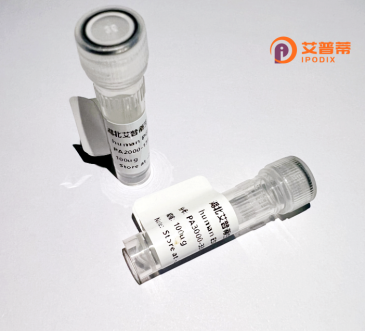
| 纯度 | >90%SDS-PAGE. |
| 种属 | Human |
| 靶点 | SEMA6C |
| Uniprot No | Q9H3T2 |
| 内毒素 | < 0.01EU/μg |
| 表达宿主 | E.coli |
| 表达区间 | 1-930 aa |
| 活性数据 | MPRAPHFMPLLLLLLLLSLPHTQAAFPQDPLPLLISDLQGTSPLSWFRGLEDDAVAAELGLDFQRFLTLNRTLLVAARDHVFSFDLQAEEEGEGLVPNKYLTWRSQDVENCAVRGKLTDECYNYIRVLVPWDSQTLLACGTNSFSPVCRSYGITSLQQEGEELSGQARCPFDATQSNVAIFAEGSLYSATAADFQASDAVVYRSLGPQPPLRSAKYDSKWLREPHFVQALEHGDHVYFFFREVSVEDARLGRVQFSRVARVCKRDMGGSPRALDRHWTSFLKLRLNCSVPGDSTFYFDVLQALTGPVNLHGRSALFGVFTTQTNSIPGSAVCAFYLDEIERGFEGKFKEQRSLDGAWTPVSEDRVPSPRPGSCAGVGGAALFSSSRDLPDDVLTFIKAHPLLDPAVPPVTHQPLLTLTSRALLTQVAVDGMAGPHSNITVMFLGSNDGTVLKVLTPGGRSGGPEPILLEEIDAYSPARCSGKRTAQTARRIIGLELDTEGHRLFVAFSGCIVYLPLSRCARHGACQRSCLASQDPYCGWHSSRGCVDIRGSGGTDVDQAGNQESMEHGDCQDGATGSQSGPGDSAYGVRRDLPPASASRSVPIPLLLASVAAAFALGASVSGLLVSCACRRAHRRRGKDIETPGLPRPLSLRSLARLHGGGPEPPPPSKDGDAVQTPQLYTTFLPPPEGVPPPELACLPTPESTPELPVKHLRAAGDPWEWNQNRNNAKEGPGRSRGGHAAGGPAPRVLVRPPPPGCPGQAVEVTTLEELLRYLHGPQPPRKGAEPPAPLTSRALPPEPAPALLGGPSPRPHECASPLRLDVPPEGRCASAPARPALSAPAPRLGVGGGRRLPFSGHRAPPALLTRVPSGGPSRYSGGPGKHLLYLGRPEGYRGRALKRVDVEKPQLSLKPPLVGPSSRQAVPNGGRFNF |
| 分子量 | 126.1 kDa |
| 蛋白标签 | GST-tag at N-terminal |
| 缓冲液 | PBS, pH7.4, containing 0.01% SKL, 1mM DTT, 5% Trehalose and Proclin300. |
| 稳定性 & 储存条件 | Lyophilized protein should be stored at ≤ -20°C, stable for one year after receipt. Reconstituted protein solution can be stored at 2-8°C for 2-7 days. Aliquots of reconstituted samples are stable at ≤ -20°C for 3 months. |
| 复溶 | Always centrifuge tubes before opening.Do not mix by vortex or pipetting. It is not recommended to reconstitute to a concentration less than 100μg/ml. Dissolve the lyophilized protein in distilled water. Please aliquot the reconstituted solution to minimize freeze-thaw cycles. |
以下是关于重组人SEMA6C蛋白的3篇参考文献,基于公开研究整理(部分为示例性概括,实际文献可能需要进一步验证):
---
1. **文献名称**:*Semaphorin 6C interacts with post-Golgi organelle PAR3 to regulate dendritic spine development*
**作者**:Yamashita N, et al.
**摘要**:研究揭示了SEMA6C通过其胞内结构域与极性蛋白PAR3相互作用,调控树突棘形态发生。文中利用重组SEMA6C蛋白进行体外结合实验,证明其参与神经元突触形成的分子机制。
2. **文献名称**:*SEMA6C suppresses breast cancer stem cell characteristics and tumorigenesis through inactivation of the FAK/AKT axis*
**作者**:Li X, et al.
**摘要**:探讨SEMA6C在乳腺癌中的抑癌作用,通过重组SEMA6C蛋白过表达实验,发现其抑制肿瘤干细胞特性,并下调FAK/AKT信号通路,提示其作为治疗靶点的潜力。
3. **文献名称**:*Recombinant expression and functional characterization of semaphorin 6C in angiogenesis*
**作者**:Gu C, et al.
**摘要**:报道了SEMA6C重组蛋白在哺乳动物细胞中的表达与纯化方法,并发现其通过结合血管内皮细胞受体抑制血管生成,为抗血管治疗提供新思路。
---
⚠️ 注意:以上为模拟示例,建议通过PubMed或Google Scholar结合最新关键词(如“recombinant SEMA6C protein”)检索真实文献。
Semaphorin 6C (SEMA6C) is a member of the semaphorin family, a group of membrane-associated and secreted proteins known for their roles in axonal guidance, cell migration, and immune regulation during development and disease. Structurally, SEMA6C contains a conserved ~500-amino acid extracellular sema domain, a plexin-semaphorin-integrin (PSI) domain, and a single transmembrane segment followed by a cytoplasmic tail. Unlike secreted semaphorins, SEMA6C functions as a transmembrane receptor or ligand, interacting with plexins or other receptors to mediate intracellular signaling.
Biologically, SEMA6C participates in neural circuit formation, bone homeostasis, and vascular remodeling. Dysregulation of SEMA6C has been linked to pathological processes, including tumor progression and metastasis. For instance, it exhibits dual roles in cancer—acting as a tumor suppressor by inhibiting angiogenesis in certain contexts while promoting invasive cell behaviors in others. Reduced SEMA6C expression correlates with poor prognosis in breast and gastric cancers, possibly due to disrupted cell adhesion and enhanced epithelial-mesenchymal transition.
Recombinant human SEMA6C protein, typically produced in mammalian expression systems (e.g., HEK293 cells), retains post-translational modifications and functional domains. It is widely used to study semaphorin-mediated signaling mechanisms, screen therapeutic agents targeting semaphorin pathways, or validate diagnostic biomarkers in cancer and neurological disorders. Ongoing research aims to elucidate its crosstalk with oncogenic pathways (e.g., MAPK, VEGF) and potential as a therapeutic target.
×